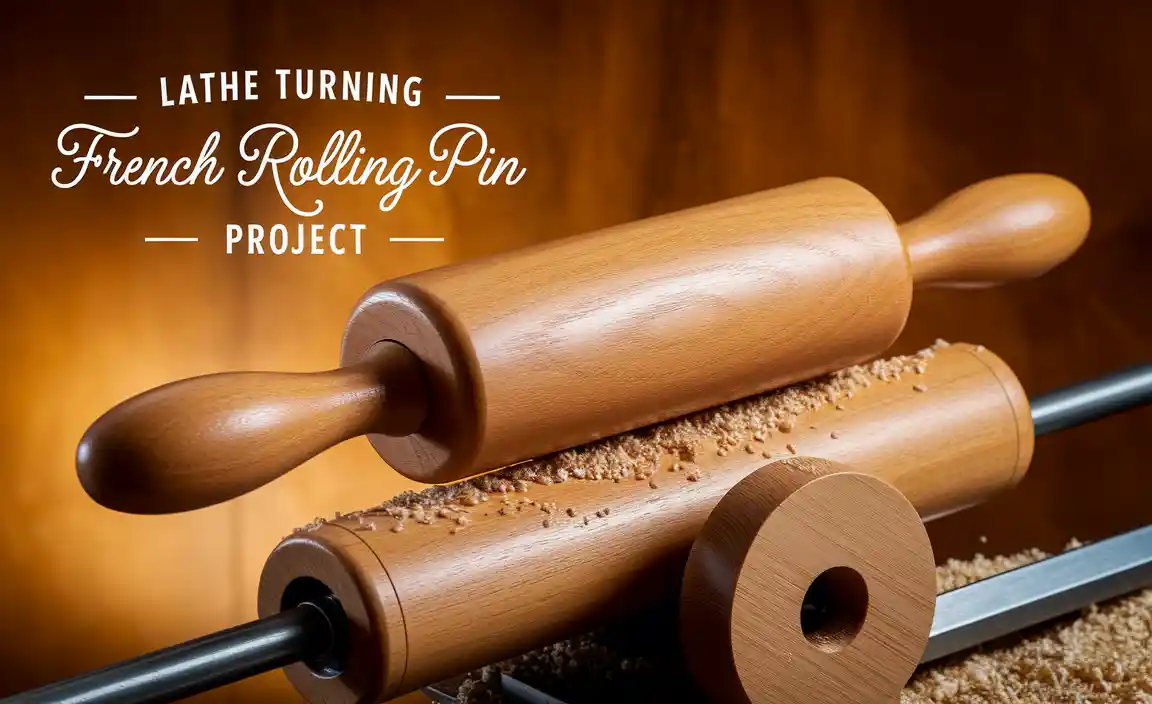A 1/8 inch carbide end mill is absolutely proven for machining titanium. When specifically designed for this tough material, these tools offer exceptional durability and precision, making even challenging titanium cuts achievable for hobbyists and professionals alike.
Hey there, fellow makers! Daniel Bates here from Lathe Hub. Ever looked at titanium and thought, “Wow, that looks tough to machine”? You’re not alone! Titanium is known for its strength and heat resistance, which is fantastic for aerospace and medical implants, but it can be a real headache for your milling tools. That frustration is why many beginners shy away from it. But what if I told you that with the right tool, even this super-strong metal can be cut with precision? We’re going to dive deep into the world of the 1/8 inch carbide end mill, and why it’s been proven as a champion for tackling titanium. Stick around, and you’ll learn how to wield this small but mighty tool like a pro!
The Mighty 1/8 Inch Carbide End Mill: Your Titanium Cutting Champion
When it comes to machining titanium, the material’s inherent toughness and tendency to work-harden can quickly doom a less-than-ideal cutting tool. Imagine this: you’re finally ready to mill that critical titanium part, you engage the tool, and suddenly there’s chatter, excessive heat, and before you know it, your end mill is toast. It’s a common nightmare for machinists, especially those working with smaller, more delicate projects or on entry-level machines. But here’s the good news: not all end mills are created equal. The 1/8 inch carbide end mill, when specifically engineered for high-performance materials like titanium, is a game-changer. This little tool packs a serious punch, offering the rigidity, heat resistance, and sharpness needed to slice through titanium like butter. In this article, we’ll explore why this specific size and material combination is so effective, what features to look for, and how to use it safely and successfully. Get ready to demystify working with titanium!
Why Titanium is a Machining Challenge
Before we get to celebrating the 1/8 inch carbide end mill, let’s first understand why titanium is such a tricky customer. It’s not just a little bit harder than steel; it has a unique combination of properties that make machining downright difficult:
- High Strength and Toughness: Titanium alloys have a very high tensile strength, meaning they resist deformation. This requires significant force to cut.
- Low Thermal Conductivity: Unlike many metals, titanium doesn’t dissipate heat well. When you cut it, the heat generated gets trapped right at the cutting edge, leading to rapid tool wear and potential melting.
- Tendency to Work-Harden: As you machine titanium, the surface layers can become harder with each pass. This makes subsequent cuts even more demanding, and can quickly dull or damage your cutting tool if not managed properly.
- Galling and Welding: Titanium has a tendency to “g %)$, with the workpiece material. This can cause built-up edge (BUE) on the cutting tool, distorting the cutting geometry and leading to tool failure.
- High Melting Point: While this is great for many applications, it means that excessive heat during machining can approach the melting point of the tool material itself, especially with inadequate cooling.
These factors combine to create a perfect storm for machining. Standard high-speed steel (HSS) end mills often struggle, rapidly dulling or failing entirely. This is where advanced materials and geometries come into play, and where our humble 1/8 inch carbide end mill shines.
The Power of Cemented Carbide
So, what makes carbide so special for tackling tough materials? Cemented carbide, often just called “carbide,” is a composite material formed by pressing and then sintering (heating to near melting point) powdered tungsten carbide with a binder metal, typically cobalt. This process creates an incredibly hard and wear-resistant material with surprisingly good toughness. Here’s why it’s ideal for titanium:
- Exceptional Hardness: Carbide is significantly harder than HSS, allowing it to resist wear and maintain its sharp edge for longer, even when cutting abrasive materials like titanium.
- High Hot Hardness: Carbide retains its hardness at much higher temperatures than HSS. This is crucial for titanium machining, where heat buildup is a major issue. It can withstand the high cutting temperatures without softening.
- Rigidity: Carbide has a higher Young’s modulus (a measure of stiffness) than steel. This means it’s less likely to flex or chatter under load, leading to more precise cuts and a better surface finish on workpieces.
- Wear Resistance: The inherent hardness of carbide makes it highly resistant to abrasion and erosion, common failure modes when machining sticky, abrasive materials.
When you combine these properties with the right geometric design and coatings, a carbide end mill becomes a formidable tool for challenging alloys.
What Makes a 1/8 Inch Carbide End Mill “Proven for Titanium”?
Simply saying “carbide” isn’t enough. For effectively machining titanium, a 1/8 inch (which is approximately 3mm or 6mm shank, depending on the shank diameter specification) carbide end mill needs specific design features. These aren’t your everyday general-purpose end mills. Look for these key characteristics:
1. Specialized Geometry
The shape of the cutting flutes and edges is critical. For titanium, you’ll want:
- Fewer Flutes: Typically, 2 or 3-flute end mills are preferred for titanium. More flutes can lead to chip packing in deeper cuts and generate more heat. Fewer flutes allow for better chip evacuation and reduce friction.
- Higher Relief Angles: This means the ‘clearance’ angle behind the cutting edge is larger. It reduces rubbing between the tool flank and the workpiece, minimizing heat buildup and preventing galling.
- Sharp Cutting Edges: Extremely sharp edges are essential to reduce cutting forces and prevent work-hardening of the titanium.
- Variable Helix Angles: Some advanced end mills feature variable helix angles (often referred to as “variable flute geometry” or “high-performance geometry”). This helps to break up harmonic vibrations, significantly reducing chatter, which is a massive problem when machining titanium.
2. Advanced Coatings
Coatings are like armor for your end mill, providing additional layers of protection and performance:
- TiAlN (Titanium Aluminum Nitride) or AlTiN (Aluminum Titanium Nitride): These are the workhorses for high-temperature machining. They form a hard, heat-resistant ceramic layer that significantly reduces friction and dissipates heat away from the cutting edge. Crucially, they create a barrier that prevents the titanium from welding to the end mill.
- ZrN (Zirconium Nitride): Sometimes used as a first layer, it offers good lubricity and wear resistance.
- DLC (Diamond-Like Carbon): While less common for solid carbide in titanium, DLC coatings provide exceptional lubricity, reducing friction and preventing material adhesion.
3. Material and Construction
- Sub-Micrograin Carbide: This refers to the fineness of the carbide grain structure. Finer grains lead to a harder, stronger, and more wear-resistant tool.
- Stub Length: For 1/8 inch diameter end mills, a “stub” or “short” length is often preferred for titanium. Shorter tools are more rigid – they have less tendency to deflect or chatter under the high cutting forces. This rigidity is paramount for maintaining accuracy and preventing tool breakage.
- Low Runout Design: “Runout” is how much the cutting edge deviates from its true rotational path. Low runout (precision ground shanks and bores) ensures that the tool cuts accurately, reduces vibration, and prolongs tool life. For demanding materials, this is non-negotiable.
Choosing the Right 1/8 Inch Carbide End Mill for Titanium
Navigating the world of end mills can be overwhelming. When you’re specifically looking for a 1/8 inch carbide end mill tested and proven for titanium, use these criteria:
Key Features to Look For (and Why)
When browsing tool catalogs or online stores, keep an eye out for descriptions that mention these features:
- “Designed for Titanium” or “High-Performance Titanium End Mill”: This is the most straightforward indicator. Manufacturers often label tools specifically made for challenging materials.
- 2 or 3 Flutes: As discussed, fewer flutes aid chip evacuation and reduce heat.
- Stub Length or Short Flute Length: This signifies increased rigidity.
- Variable Helix / High Helix Angle / Anti-Vibration Geometry: These terms all point to designs that combat chatter. A common high-performance helix angle for titanium can be around 45 degrees, with some going up to 50 degrees or more for advanced anti-vibration designs (also called “multiple helix”).
- TiAlN or AlTiN Coating: This purple/black or iridescent coating is your best bet for heat resistance and preventing galling.
- Sub-Micrograin Carbide: Often mentioned as a sign of quality and durability.
- High Precision Tolerance / Low Runout: While sometimes harder for beginners to quantify, reputable manufacturers will often specify tight tolerances on their tools.
Example of a High-Quality End Mill (Speculative)
Let’s imagine a top-tier 1/8 inch carbide end mill designed for titanium:
| Specification | Description for Titanium Machining |
|---|---|
| Diameter | 1/8 inch (0.125 inches or 3.175 mm) |
| Shank Diameter | 1/8 inch (for maximum rigidity on small machines) or 1/4 inch (for slightly more stability if your machine can handle it) |
| Length | Stub Length (e.g., 1.5 to 2 inches overall length, with ~1/4 to 3/8 inch flute length) |
| Number of Flutes | 2 or 3 |
| Helix Angle | Variable Helix (e.g., 40-45 degrees per flute) or High Helix (>30 degrees) for vibration dampening. |
| Edge Preparation | Sharp, polished cutting edges with slight corner radius (e.g., 0.002″ to 0.005″) to prevent chipping. |
| Coating | TiAlN or AlTiN (provides excellent heat resistance and lubricity). |
| Carbide Grade | Sub-micrograin carbide for superior hardness and wear resistance. |
| Runout Tolerance | Tight tolerance (e.g., less than 0.0005″ TIR – Total Indicator Runout) for precision. |
You might see specifications referencing “grade 5 titanium” or similar. Grade 5 titanium (Ti-6Al-4V) is the most common alloy used in many applications, known for its excellent strength-to-weight ratio. Tools “proven for titanium grade 5” are specifically designed and tested to perform well on this alloy.
Where to Find These Tools
You won’t typically find these specialized end mills at your local big-box hardware store. Look to:
- Specialty Machining Tool Suppliers: Companies like Widell, LMT Onsrud, YG-1, Sandvik Coromant, Iscar, and many others offer high-performance end mills.
- Online Machining Tool Retailers: Websites dedicated to selling machinist tools will carry a wider selection.
- Manufacturer Websites: Directly browsing at the source can help you identify suitable product lines.
While these specialized end mills can be more expensive upfront than general-purpose ones, their longevity and performance when cutting titanium make them a cost-effective choice in the long run. Investing in a quality tool saved me a lot of headaches and ruined projects early in my career!
Setting Up for Success: Machine and Workpiece Considerations
Even the best end mill can fail if the setup isn’t right. Machining titanium with a 1/8 inch carbide end mill requires attention to detail in your machine setup and workpiece fixturing.
Machine Rigidity is Key
A 1/8 inch end mill, especially a stub-length one, gives you some advantage, but your machine still needs to be up to the task. Titanium requires substantial cutting forces and is unforgiving of flex.
- Stiff Machine: A CNC mill with a rigid frame is ideal. Hobby machines or mills with a lot of play in the ways or Z-axis will struggle. Ensure all gibs are properly adjusted.
- Powerful Spindle: You need a spindle that can deliver consistent torque at the required cutting speeds and feeds. A weak spindle will bog down.
- Tool Holder Quality: Use a high-quality, precision tool holder. A CAT 40 or BT40 taper is great; for smaller machines, a well-balanced ER collet chuck with minimal runout is essential. A cheap R8 collet can introduce significant runout.
- Cleanliness: Ensure your spindle taper and tool holder are spotlessly clean. Any debris can cause runout and vibration.
Workpiece Fixturing
Your titanium workpiece needs to be held down securely and without flex. Any movement will lead to tool breakage or poor surface finish.
- Solid Clamping: Use robust clamps that grip the workpiece firmly without deforming it. Avoid clamping on thin sections if possible.
- Use Parallels or Fixture Plates: Elevating your workpiece using parallels or a fixture plate allows clamps to be positioned without interfering with the cutting path and ensures a solid base.
- Minimize Overhang: Keep the workpiece as close to its support structure as possible to prevent bending.
- Consider a Vise: A quality machinist vise with hardened jaws is often the best way to hold smaller titanium parts securely.
Coolant and Lubrication
This is absolutely critical and often overlooked for titanium. The goal is to keep the cutting edge cool and lubricated.
- Flood Coolant: A high-pressure, high-volume flood coolant system is ideal. This provides significant cooling and chip flushing.
- MQL (Minimum Quantity Lubrication): Some specialized systems deliver a very fine mist of lubricating fluid directly to the cutting zone. This is efficient for both cooling and lubrication with minimal mess.
- Cutting Fluid/Oil: Use a cutting fluid specifically formulated for difficult-to-machine metals or titanium. Avoid general-purpose oils. Some sulfur-based cutting oils are excellent for preventing galling.
- Air Blast: In some cases, a strong blast of compressed air can help cool the cutting zone, but it’s usually insufficient on its own for titanium.
A good resource for understanding cutting parameters and strategies for tough materials can be found through organizations like NIST (National Institute of Standards and Technology), which conducts research into advanced manufacturing processes, including machining of exotic materials.
Setting Your Speeds and Feeds
This is where the “proven for titanium” advice really comes into play. Titanium requires different cutting parameters than steel or aluminum. The general advice for 1/8 inch carbide end mills in titanium is:
- Lower Surface Speeds: Titanium needs slower surface speeds than many other metals. Typically, for 1/8 inch carbide, you might start in the range of 50-100 Surface Feet Per Minute (SFM).
- Higher Chip Load (Feed per Tooth): While slower overall, a decent chip load is important to ensure you’re actually cutting material and not rubbing. For a 1/8″ end mill, this might be in the range of 0.001 to 0.003 inches per tooth.
- Conservative Depth of Cut: Especially when learning, use shallow Axial Depths of Cut (ADoC) – perhaps 0.020″ to 0.050″, and Radial Depths of Cut (R
aD
oC) of 20-50% of the tool diameter. This minimizes heat buildup and cutting force.
Example Calculation (for a 1/8″ end mill):
Let’s say your end mill has a 1/8 inch diameter (0.125 inches) and you’re aiming for 75 SFM.
Spindle Speed (RPM) = (SFM × 3.82) / Diameter (inches)
RPM = (75 × 3.82) / 0.125 = 2865 / 0.125 = 2292 RPM
Now, if you want a feed per tooth of 0.002 inches:
<






